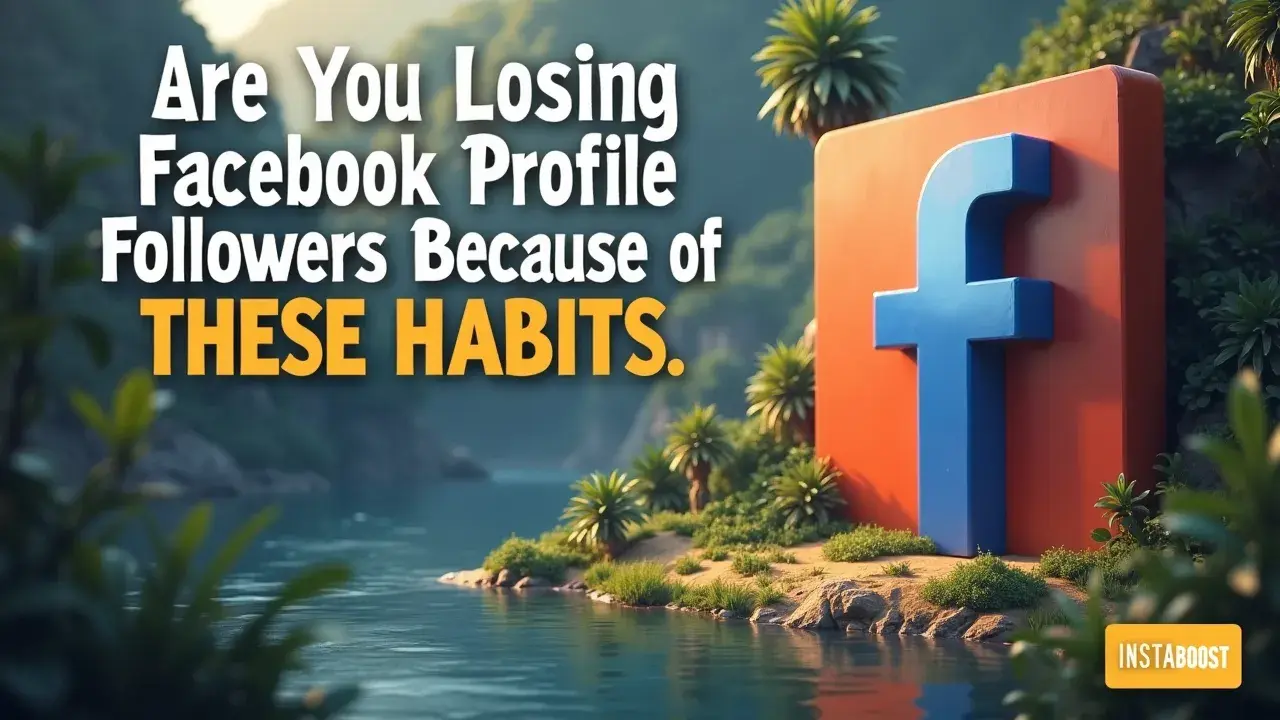Are You Losing Facebook Profile Followers Because of These Habits?
Consistent, intentional content helps followers stay. A steady posting cadence, clean visuals, and concise updates reduce unfollows, especially when early engagement holds in the first hour. Track saves and profile clicks together; when both rise over two weeks, follower growth typically stabilizes. Aim for a clear brand story with human moments and timing that converts attention into lasting growth.
The Quiet Ways You Bleed Followers
Losing Facebook followers usually isn’t about one bad post. It’s a slow stack of small, unfocused habits that make things feel one-sided or hard to read. When your voice flips from friendly to pushy without any lead-in, people stop trusting you. When you tease “big news soon” and then it never shows up, they tune out. When comments sit there with no response, it feels like you’re broadcasting instead of building a group. None of this is dramatic; it’s the little frictions that add up.
The good part is each one has a simple fix. Set a steady voice: decide how you sound on a good day and keep using that, so people don’t have to re-meet you every time they open the app. When you promote something, make the value clear in plain terms: what they’ll learn, save, or get, not just what you want. Answer comments in ways that keep the thread going – ask a follow-up, tag a helpful post, summarize what others shared. Look at your posting rhythm, not by how often you show up, but by how predictable and useful the mix feels.
A simple pattern – teach something, share a behind-the-scenes moment, invite a discussion, then promote – can keep the feed steady without making it stiff. Watch unfollows and post hides in Facebook Insights; those patterns tell you where the message missed. This isn’t about gaming the algorithm or chasing shiny numbers. It’s about removing the little habits that wear down goodwill so your actual point of view can land. If you want casual scrollers to stick around, treat each post like a small promise: specific, consistent, and worth their time. That shift can slow the leak and start rebuilding trust, even if it takes a while and a few quiet adjustments you keep showing up for and boost your Facebook visibility without changing what you stand for.

Why Your Followers Trust Meter Keeps Dropping
After you’ve watched enough posts miss, you start noticing what actually sticks. Credibility on Facebook isn’t a trick; it’s people checking patterns as they scroll. They look for a steady story across posts, sources beyond “trust me,” and signs you’re present when they comment. Skip any of that and the unfollows happen quietly. A common leak is tone swings. If yesterday was a simple behind-the-scenes lesson and today is a hard pitch with no lead-in, it reads like a handoff, not help.
Another is vague self-promo without proof. Screenshots of praise aren’t evidence; a quick outcome, a before-and-after, or a clear source link is. Consistency also shows up in your timing and topics. If your pillars are fuzzy, your feed starts to feel random and your story blurs. A simple way to tighten it: pick three lanes – teach, show, invite – and tag each post before it goes up. Credibility grows when you answer with specifics instead of boilerplate.
Even “Here’s the template I used” can turn a scroll into a save. And check your claims. If you say “Top 1%,” link the ranking. If you share results, add enough context for someone to sanity-check them. That’s how you slow the follower drop: make proof easy to verify, keep your tone steady, and show you’re around. People searching “how to build social proof on Facebook” stick around when your feed reads like a well-sourced conversation, not a rotating billboard and buy Facebook followers instantly that gets you flagged.
Stack Your Signals, Not Your Slogans
Stack your signals, not your slogans. Your edge is probably in how you stack things, not how you blast them. Treat your strategy like a playlist: each post builds on the last so people feel a throughline, not a jerk from one lane to another. If followers are dropping on Facebook, it’s often because you’re hopping between promo, meme, and rant with nothing connecting them. Pick three lanes and run them every week: a short tip that teaches, a proof point that shows the result, and a question that invites people in. Keep a steady backbone so your tone doesn’t swing from helpful to sales-heavy overnight.
When you make a claim, link the source. When you share a win, say what you learned. When you ask a question, check back within an hour and keep the thread moving. That rhythm builds trust. Use light scaffolds: recurring openers, consistent thumbnail styles, and a simple CTA set – save, try, reply – so people know what to do without feeling pushed. Measure what actually lands: saves, replies, profile taps beat raw reach.
If comments spike but hides go up, the tone’s off. If saves climb on how-to reels, make more of those and cut the filler. Borrow a newsroom cadence: post, pin a clear takeaway or a standout comment, then follow up with a post that answers the best question. For Facebook Search, title posts with plain nouns people type – “Facebook engagement checklist,” “caption ideas for small businesses” – so your archive shows up when someone looks, and remember that fads like buy Facebook likes for reels won’t fix weak structure. Strategy here isn’t about being loud; it’s about being clear, connected, and steady enough that people recognize you before they see your name.
When “Mixing It Up” Becomes Whiplash
This might not look like progress, but it could be. Posting a meme, then a think piece, then a hard sell can feel like variety; to followers, it looks like there’s no center. The answer isn’t cutting formats. It’s having a spine so each one feels like a chapter, not a random turn. If your Facebook numbers are slipping, check for tonal snapbacks: a jokey caption on a serious update, a crisis post followed by affiliate links, an inspirational quote that ignores yesterday’s conversation. People don’t need sameness; they need continuity – signals that the same person is thinking out loud from different angles.
Borrow from solid newsletters: one theme, several riffs. On Monday, ask a question. Midweek, share data or a source beyond “trust me.” Friday, add a personal take that ties both together, and in the comments, link back and tag the earlier post. That gives the thread some tension without repeating yourself. Look at your last nine posts and circle the ones that clearly connect. If you can’t draw a line, your audience can’t either.
A simple pillar list – three lanes with examples, sample phrasing, and typical CTAs – keeps “random” from pretending to be range. Range is exploring; random is avoiding the throughline. Another tell: if every caption has to rebuild context from scratch, you’re starting a new story every time, which works against retention on social. Put the throughline in the first sentence, give people a handhold, and they’ll follow you into more formats, not fewer. That’s how you stop leaking trust without sanding down who you are.
And if that feels stiff at first, it’s fine to practice it in your notes before you hit publish, to hear how it lands in your own head first, then out loud in the feed, where people actually meet you day to day… and like any channel, it helps to understand how distribution mechanics work, not just storytelling, which some folks try to shortcut with things like boost your reach: buy Facebook views, but the durable move is building a rhythm your audience recognizes.
Make the Follow Worth Something
If it made you uneasy, that’s your cue. The small churn you’re seeing isn’t random; it’s telling you whether your presence holds together. If you want people to stop unfollowing your Facebook profile, make the follow worth something, not a quick dopamine hit. Show up on a clear rhythm (when you post), use a recognizable lens (how you interpret what you share), and make a simple promise (what’s coming next). Tie it back to your spine: if your theme is “behind‑the‑scenes problem solving,” even a meme should point to the process, not drift into noise. Build small rituals that compound: a weekly thread to recap what you learned, a pinned comment with one focused question, a follow‑up post 24 hours later saying what changed because of the discussion.
That’s how lurkers start to speak up, and how participation turns into attachment. Fix the quiet trust leaks too: reply to comments within a day, say what you won’t post (so surprises feel like range, not whiplash), and swap vague self‑promo for a clear next step and one proof point. Treat every post like a chapter with a breadcrumb to the next: “Tomorrow I’ll share the template,” “Next week I’ll test this in public.” You’re building an arc, not a feed. The algorithm cares about session time; people care about a story they can follow. Do both and your reach stops feeling like luck. The aim isn’t louder – it’s legible. When your presence becomes a dependable shortcut to a specific kind of value, unfollows slow down, shares climb, and the room gets a little smarter because you’re in it and grow your Facebook audience with shares you earn, not noise you chase.
Start With a Spine, Not a Schedule
You’re not losing Facebook followers because you posted at 9:07 a.m. instead of noon; you’re losing them because people don’t know why they should stick around. Before you tweak timing or frequency, set your center of gravity: what you stand for, the questions you return to, and the filter you use for news, memes, and personal updates. That gives variety a throughline. Without it, “mixing it up” turns into whiplash – one day a thoughtful note, the next an unrelated affiliate link – and people opt out.
Make the follow worth it by setting three anchors: rhythm (when you show up), lens (how you interpret what you share), and promise (what’s coming next). Then test it. If a post idea can’t be explained through your lens in one sentence, it’s off-theme or needs another pass. If comments sit unanswered, you teach your audience not to bother; give yourself 24 hours to acknowledge the first wave. If you sell, sell like a guide: say who it’s for, the outcome, and one proof point – not just “link in bio.” That’s how you protect reach without sanding off who you are. The quiet killer isn’t volume; it’s inconsistency of meaning. Give people a clear thread to follow, and your posts start to feel like chapters in one story instead of scattered pieces in a crowded feed, which matters far more than chasing tricks like a “best time to post” hack on Facebook and real-looking Facebook emoji service myths.















